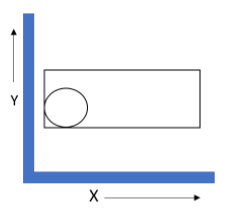
Let us assume that a sphere of mass $1kg$ rests at one corner of a cube. The cube has been moved with a velocity $\vec{v}=8t\hat{i}-2{{t}^{2}}\hat{j}$ where $t$ be time in second. What will be the force by sphere on the cube at $t=1$? $\left( g=10m{{s}^{-2}} \right)$ [The diagram represents the vertical plane of the cube].

$\begin{align}
& A.8N \\
& B.10N \\
& C.20N \\
& D.4\sqrt{5}N \\
\end{align}$

Answer
557.7k+ views
Hint: Acceleration of the cube will be found by taking the derivative of this equation of velocity. The pseudo force on the sphere will be found by taking the product of the mass of the sphere and the acceleration of the sphere. The magnitude of the force will be the square root of magnitude of each component of the force. This will help you in answering this question.
Complete answer: It has been given that the cube is moving with a velocity given as,
$\vec{v}=8t\hat{i}-2{{t}^{2}}\hat{j}$
Acceleration of the cube will be found by taking the derivative of this equation of velocity. That is,
$a=\dfrac{dv}{dt}=8\hat{i}-4t\hat{j}$
It has been mentioned in the question that the time taken be,
$t=1$
Substituting this in the equation will give,
$a=8\hat{i}-4\hat{j}$
The pseudo force on the sphere will be given as
$F=-m\dfrac{dv}{dt}$
Where $m$ is the mass of the sphere.
The mass of the sphere has been mentioned in the question as,
$m=1kg$
Substituting the acceleration and mass of the sphere in the equation of force will give,
$F=-8\hat{i}+4\hat{j}$
Therefore the magnitude of the force will be the square root of magnitude of each component of the force. That is,
$\left| {\vec{F}} \right|=\sqrt{64+16}=\sqrt{80}=4\sqrt{5}N$
Therefore the magnitude of the force in this situation has been calculated.
The correct answer has been mentioned as option D.
Note:
The acceleration can be defined as the rate of variation in the velocity of the body with respect to the time taken. The velocity of the body can be defined as the rate of variation of the displacement with respect to time taken. Both these quantities are vectors having both magnitude and direction.
Complete answer: It has been given that the cube is moving with a velocity given as,
$\vec{v}=8t\hat{i}-2{{t}^{2}}\hat{j}$
Acceleration of the cube will be found by taking the derivative of this equation of velocity. That is,
$a=\dfrac{dv}{dt}=8\hat{i}-4t\hat{j}$
It has been mentioned in the question that the time taken be,
$t=1$
Substituting this in the equation will give,
$a=8\hat{i}-4\hat{j}$
The pseudo force on the sphere will be given as
$F=-m\dfrac{dv}{dt}$
Where $m$ is the mass of the sphere.
The mass of the sphere has been mentioned in the question as,
$m=1kg$
Substituting the acceleration and mass of the sphere in the equation of force will give,
$F=-8\hat{i}+4\hat{j}$
Therefore the magnitude of the force will be the square root of magnitude of each component of the force. That is,
$\left| {\vec{F}} \right|=\sqrt{64+16}=\sqrt{80}=4\sqrt{5}N$
Therefore the magnitude of the force in this situation has been calculated.
The correct answer has been mentioned as option D.
Note:
The acceleration can be defined as the rate of variation in the velocity of the body with respect to the time taken. The velocity of the body can be defined as the rate of variation of the displacement with respect to time taken. Both these quantities are vectors having both magnitude and direction.
Recently Updated Pages
Master Class 11 Business Studies: Engaging Questions & Answers for Success

Master Class 11 Computer Science: Engaging Questions & Answers for Success

Master Class 11 Maths: Engaging Questions & Answers for Success

Master Class 11 Chemistry: Engaging Questions & Answers for Success

Master Class 11 Economics: Engaging Questions & Answers for Success

Master Class 11 Accountancy: Engaging Questions & Answers for Success

Trending doubts
What is meant by exothermic and endothermic reactions class 11 chemistry CBSE

10 examples of friction in our daily life

One Metric ton is equal to kg A 10000 B 1000 C 100 class 11 physics CBSE

1 Quintal is equal to a 110 kg b 10 kg c 100kg d 1000 class 11 physics CBSE

Difference Between Prokaryotic Cells and Eukaryotic Cells

What are Quantum numbers Explain the quantum number class 11 chemistry CBSE




